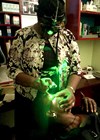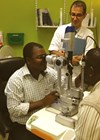Contributors: Rosie Brennan, Anshul Chauhan, Mona Duggal, John Ellis, Michael Gichangi, Edwin Grayson, Catherine Jamieson, Ankita Kankaria, Oliver Kemp, Hendra Kusuma, Nanda Matthew, Geeta Menon, Habibah Muhiddin, Tunde Peto, Recivall Salongcay, Frank Sandi, Hazel Shillingford-Ricketts, Bernadetha Shilio, Caroline Styles, Sharon Tench-Norbal, Elanor Watts and Dyah Windy
According to the Lancet Commission on Global Eye Health [1], there has been a reduction in the age-standardised prevalence of blindness and visual impairment in the last decade. However, the absolute numbers are increasing due to ageing and the increasing world population.
There is also a shift to conditions that are not easy to treat and are due to increased urbanisation and industrialisation, reflected in an increase in the prevalence of non-communicable diseases (NCDs) such as diabetes mellitus (DM). There is a need to strengthen interventions to combat this surge in blindness. A weak link to achieving this in low- and middle-income countries (LMICs) has been identified as the shortage of human and material resources. Enhancing the training and skills of eyecare professionals was one of the targets of VISION 2020: The Right to Sight [2]. The VISION 2020 LINKS Programme was introduced 16 years ago to build partnerships to improve the skills of eye health workers including through task shifting / sharing and enhancing outreach services to reach rural and vulnerable groups [3].
DR-NET Workshop June 2021
The Diabetic Retinopathy Network (DR-NET) is made up of 30 LINKS in 20 countries. DR-NET provides a platform for sharing and learning opportunities among eye departments to address priority needs and improve diabetic eyecare through skills transfer, training and development of DR guidelines [4].
To explore the opportunities, challenges and adaptations made to DR services (DRS) during the COVID-19 pandemic, an international workshop was held in June 2021 with several interesting, stimulating and diverse presentations from different regions.
This article summarises the presentations of experiences, successes and suggested actions and recommendations from the two-hour workshop.

Counselling a patient with DR in Dominica.
Shared experiences of the participating centres
This was rich and diverse, as every centre used their locally-available resources to achieve the programme objective – to prevent at least an extra one person per week from losing their sight from DR. Nurse-led DR screening started in Chandigarh, India in February 2020. Prior to this, between 2018 and 2020 there had been the signing of the Memorandum of Understanding to establish a LINK with Frimley Park Hospital in the UK, training of the eyecare team, baseline assessments and linking of primary care to tertiary centres. Though screening was disrupted by the pandemic, other activities such as online training of graders and equipping of 22 primary centres in Punjab and Haryana districts were undertaken during 2020.
In St Lucia, the DR programme started in 2017 with a total of 3600 people screened to date and a treatment uptake of 100%. The presentation showed the magnitude of DR on the island and the steps taken to reduce loss of sight.
The presentation from Dominica explained that DRS started in 2005 but were expanded for increased coverage to 1500 per year in 2019 with a mobile on-phone digital camera and two international Gloucester Retinal Education Group (GREG) certified graders. However, the optimal number of people to be screened per year (6500) to achieve maximum coverage is yet to be reached. The team is currently piloting an artificial intelligence assisted grading system which may help overcome some of the barriers to scale up the programme.
The team in South Sulawesi, Indonesia, provide mobile DR services using a vehicle fitted with a camera and a laser so that screening and treatment can be done inside the vehicle; only if vitrectomy is needed are patients referred to the main DR centre in Makassar City. Their next stage of development of DR services is to increase from six to nine centres, better serving the whole of South Sulawesi.
In Tanzania, DRS are embedded within the NCDs section of the Ministry of Health, Community Development, Gender, Elderly and Children. There are three government screening and treatment referral centres, one centre with screening activities and another yet to start. Training of screener / graders and obtaining funding for equipment is ongoing. The centre in Dodoma will be the first in the central part of Tanzania. At the moment, patients have to travel up to 12 hours to access treatment in Moshi. DRS in Mbeya started in May 2018. The centres mostly receive patients with advanced DR; people with Type 2 diabetes have to pay for screening services.
The screening activities of the DR UK-Philippines remote Retinal Evaluation and Collaboration in Health (DR-REACH) programme started in February 2021. The presentation demonstrated the effectiveness of taking screening outside the clinics using a portable hand-held digital camera to increase coverage in the community. A total of 623 patients have been screened in three months and the goal is to screen 5000-10,000 before the end of 2021, as well as roll out to other regions of the country.
In Kenya over 17,000 patients have been screened and 3000 treated within the DRS programme since its inception in 2014. An additional 5000 have been treated by the private sector between 2014 and 2018. The programme expanded to be more inclusive towards DM care in general and this led to screening for other complications of diabetes such as diabetic foot. This in turn increased the number coming in for DR screening, an unintended benefit.
Successes of the DR programmes
These included:
- Ownership and involvement of the country’s Ministry of Health in all the participating centres.
- Integration with other health programmes such as the NCD programme in Tanzania and within national strategic plans, such as in Kenya.
- Accessibility in the area of cost such as in St Lucia where screening is free.
- Development of national guidelines and training of staff in their use leading to standardisation of services nationally, as reported from Kenya.
- Evidence generation to inform new and improved services, for example, in India where investigations into factors of non-uptake of the services and strategies to combat them is ongoing.
- Testing of artificial intelligence (AI) software in Dominica to see if it grades DR in retinal images in a community setting with the same accuracy as human specialist graders.
- Evidence that task shifting screening to technicians using digital fundus cameras in Kenya has increased access to DRS three-fold.
Challenges within the DR centres
Some of the challenges included:
- The COVID-19 pandemic – the challenge experienced by all the centres was a dip in the number of patients between February and May 2020 caused by cessation of services due to government restrictions. For example, in St Lucia there was a 30% and 3% reduction in numbers screened and treated respectively between 2019 and 2020. Patients with DM were vulnerable and classified as high-risk groups, which created an additional impediment. Others were staff shortages due to re-assignment for COVID-19 front-line duty, as well as instructions to work from home. The impact of this gave rise to administrative delays, worsening DR symptoms, patients’ loss to follow-up, increase in vision-threatening DR, late-stage presentation and permanent vision loss.
- Access to services due to difficult terrain, natural disasters and mountainous areas in the islands of Indonesia, Dominica and the Philippines.
- Limited number of staff.
- Non-uptake of services by patients.
- Costs, in countries where screening is not free for people with Type 2 DM.
- Funding for training and equipment.
Adaptations to the challenges
Some of the adaptations included:
- Mobile DR screening and treatment van to increase community coverage in Indonesia.
- Evidence generation to inform adaptation and overcome staff limitations, such as in Dominica with AI research.
- COVID-19 adaptations include tele-ophthalmology, rescheduling of missed appointments via phone, timed appointments to reduce the number of patients, abiding with safety protocols – use of facemasks / shields, social distancing, wiping of commonly shared surfaces and equipment, and screening for sick patients.
Suggested actions and recommendations
A review of innovative ophthalmic practice during COVID-19 indicated tele-ophthalmology, task-shifting, changes in medical education and use of artificial intelligence as options. Tele-ophthalmology can be achieved by shifting basic eye testing such as visual acuity and administrative activities to be done at home by the patient [5], or remote monitoring [6], where the patient gets retinal investigations such as optical coherence tomography scan or retinal photograph within their locality and only goes to the clinic if there is a concerning finding. A third option is by remote consultations [7] through a technician- or optometrist-manned eye unit and video-conferencing to an ophthalmologist, with a vitreoretinal expert on hand if referable disease is present.
This reduces delays and has been shown to reduce international imbalance in a specific setting [8]. Conversely, caution should be employed so as not to widen the equity gap that may arise towards the elderly, those not computer-literate, minority and low socioeconomic groups [9] who have limited internet or smartphone access [10].
The LINKS Virtual Toolkit [11] was presented. Online training is more inclusive, as many more people have access immediately and for longer periods than traditional training courses. Its drawback includes the cost of data which may require securing additional funding, especially if the cost of internet is not affordable, as in certain African countries (see Figure 1).

Figure 1: Affordable internet means 1GB of data costs less than 2% of monthly income,
indicated by the blue areas on the map (Countries in Africa depicted in grey had no data available).

Figure 2: Diagram showing the extra number of women with blindness
(horizontal axis) and visual impairment (vertical axis) by country.
Conclusion
The workshop concluded with a thought-provoking proposition regarding the evidence on gender inequity in eye health (see Figure 2). DR-NET should investigate whether this also occurs in DRS and start collecting and reporting DR-NET data by gender. More than 80% of the participants agreed to collect and report their data on screening and treatment disaggregated for gender.
The evaluation polls revealed that 90% of the participants felt that the workshop met their expectations, while 98% learnt something new and 95% gained new information that will change their practice positively. The workshop was a huge success, thanks to the organisers, active participants and eloquent presenters.
References
1. Burton MJ, Ramke J, Marques AP, et al. The Lancet Global Health Commission on Global Eye Health: vision beyond 2020. The Lancet Global Health 2021;9(4):e489-551.
2. Rao GN. The achievements and lasting effects of VISION 2020. Eye News 2020;26(6):3-5.
3. Zondervan M, Msukwa G, Onyango J, et al. VISION 2020 LINKS Programme: The contribution of health partnerships to reduction in blindness worldwide. Eye News 2020;26(6):7-12.
4. Astbury N, Burgess P, Foster A, et al. Tackling diabetic retinopathy globally through the VISION 2020 LINKS Diabetic Retinopathy Network. Eye News 2017;23(5)
5. Gunasekeran DV, Tham YC, Ting DS, et al. Digital health during COVID-19: lessons from operationalising new models of care in ophthalmology. The Lancet Digital Health 2021;3(2):e124-34.
6. Galiero R, Pafundi PC, Nevola R, et al. The Importance of Telemedicine during COVID-19 Pandemic: A Focus on Diabetic Retinopathy. Journal of Diabetes Research 2020;2020:1-8.
7. Ghazala FR, Dall’Ozzo S, McGowan G, Livingstone IA. Teleophthalmology-Enabled Direct Vitreoretinal Surgery Listing from Community Optometric Practice: Enhanced Efficiency During Coronavirus Disease 2019, and Beyond? Telemedicine and e-Health 2021;27(7):816-9.
8. Yousef YA, Al-Nawaiseh I, Mehyar M, et al. How telemedicine and centralized care changed the natural history of retinoblastoma in a developing country: Analysis of 478 patients. Ophthalmology 2021;128(1):130-7.
9. Nouri S, Khoong EC, Lyles CR, Karliner L. Addressing equity in telemedicine for chronic disease management during the Covid-19 pandemic. NEJM Catalyst Innovations in Care Delivery 2020;1(3):1-13.
10. Scanzera AC, Kim SJ, Chan RP. Teleophthalmology and the digital divide: inequities highlighted by the COVID-19 pandemic. Eye 2021;35:1529-31.
11. ICEH. Toolkit – how to run a virtual LINK. 2021:
https://iceh.lshtm.ac.uk/files/
2021/07/4.-Toolkit-for-running
-a-virtual-LINK_new-july-2021.pdf
(Last accessed August 2021).
COMMENTS ARE WELCOME









